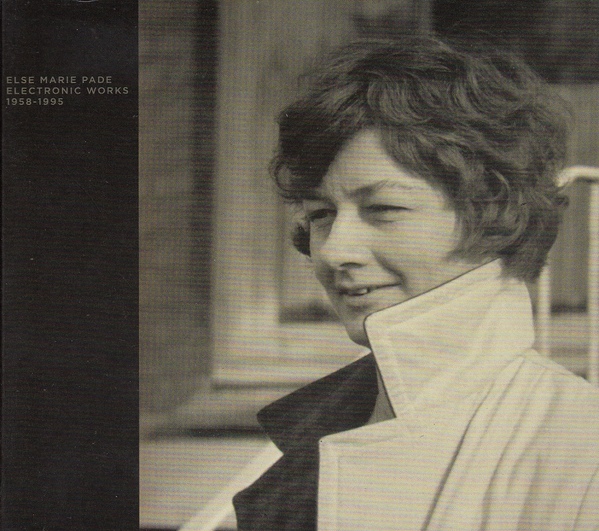
 |
|
 |
Format: do-CD Label & Cat.Number: Important Records IMPREC406 Release Year: 2014 Note: collection of the most important works (1958-1995) by the Danish pioneer of electro-acoustic music, who studied with PIERRE SCHAEFFER, included are: "Faust Suite", "Illustrationer", "Glasperlespil I & II"; curated by JAKOB KIERKEGAARD => amazing electronic compositions, very minimal & subtle, which reminded us on some works of ASMUS TIETCHENS for example...
Price (incl. 19% VAT): €19.00 Warning: Currently we do not have this album in stock!
More Info"Else Marie Pade, born in 1924 in Denmark, is a precious golden gem in the world of contemporary electro-acoustic music. She is a true pioneer of electronic music and musique concrète. Pade is Denmark's first lady of electronic music and her piece 'Syv Cirkler (Seven Circles)' became the first electronic piece performed on Danish radio. Pade's fascination with sound began in early childhood. Isolated in her bed for long periods due to illness, she began listening and intensively observing the sounds around her. As a teenager being imprisoned for spying on Nazi compounds in Arhus, she had a similar experience of isolation and sharpening her awareness of sound. Once released from prison, she became a piano student at the Royal Danish Conservatory of Music in Copenhagen. When she was introduced to Pierre Schaeffer in 1952, she instead chose to pursue the nuances of her inner sound-world. Shortly after beginning her studies with Schaeffer, she had her first electronic composition premiered in 1958. Else Marie Pade's Electronic Works 1958-1995 is a double CD set of Pade's most important compositions which was restored and mastered at Dubplates & Mastering in 2014 in Berlin under the watchful ears of curator Jacob Kirkegaard. 'The sounds outside became concrète music, and in the evening I could imagine that the stars and the moon and the sky uttered sounds and those turned into electronic music'. Else Marie Pade" [label info]www.importantrecords.com "The Danish composer Else Marie Pade's compositions of scintillating electronic minimalism and sprawled musique concrete were born nearly sixty years ago, but it wasn't until 2000 or so, when she reached the age of 74 that any of her work was actually published. Her history is an intriguing one, as she was an active participant in the Danish resistance during WWII, was arrested for her acts of sedition, and began composing in her head during her imprisonment. After the war and upon her early career as a radio producer, she discovered Pierre Schaeffer's ideas for musique concrete; and in 1952, she travelled to Paris to study with him. By the mid '60s, she had spent several summers at Darmstadt studying with Stockhausen. Her first compositions began in the early '50s and she continued to work up until the '70s when her personal life dictated that she put music aside. Throughout the '80s and '90s, Pade had all but disappeared from the public eye, with Denmark holding little regard for avantgarde composition even if were by a pioneering Dane; but by the turn of century, the academic imprint Dacapo collected Pade's work for the first time. Slowly, her work was being rediscovered, eventually leading to her breakthrough album Svaevninger with Jakob Kirkegaard. This anthology mostly centers on the earliest works of Pade's career, though the vocabulary she has developed over the decades is remarkably consistent - sinewy lines of electronic tone, perpetually fluctuating granular synthesis, and eerie clusters of melody. The "Faust Suite" from 1962 is a suitably brooding piece of electric miasma dotted sporadically with echo-delay patterned snippets of narration from the Goethe classic. Pade was not interested in creating a radio-play out of the text, instead focusing on an impressionist mood engineering of internal friction, angst, and emptiness. "Syv Cirkler" from 1958 marks the earliest work from this anthology, as a commission from the 1958 Expo whereby she crafted a celestial work of ringing tone colors and satellite-chirp sequencing that's very ahead of its time. The 1995 piece "Illustrationer" is remarkably similar to all of the work she had done earlier on, though she does layer prepared piano and aqueous field recordings into the digitally rendered work. The anthology concludes with "Glasperlespil" - a composition of stately loops and monochromatic passage with enough poetic austerity that inspired Stockhausen to include the piece in his lectures about electronic music from the '70s onward. A fantastic, enterprising collection! (NB. also available as a rather more expensive triple vinyl lp set, we'll have those back in next week.)" [Aquarius Records] |
| © 2007 Drone Records | | Celler Strasse 33, 28205 Bremen, Germany | Privacy and cookies policy | Impressum / Allgemeine Geschaftsbedingungen / Haftungsausschluss | Links to the scene |